Al Gomez
Al Gomez is the President and Founder of Dlinkers -- a company dedicated to providing complete digital marketing services. With more than ten years of experience, he enjoys supporting smartpreneurs like himself to achieve online success.
For many content writers and marketing professionals, one of the best WordPress SEO plugins available is Yoast SEO. Downloaded over 4.5 million...

Image Credits: pexels
For many content writers and marketing professionals, one of the best WordPress SEO plugins available is Yoast SEO.
Downloaded over 4.5 million times, Yoast does so much more than improving a website’s SEO. The plugin also goes the extra mile by taking care of every technical optimization there is.
It’s the famous all-in-one SEO tool that has many key plugin features. But when it comes to determining whether the content is well optimized and acceptable by the general web’s standards, Yoast’s page analysis is the plugin a lot of marketers prefer to use.
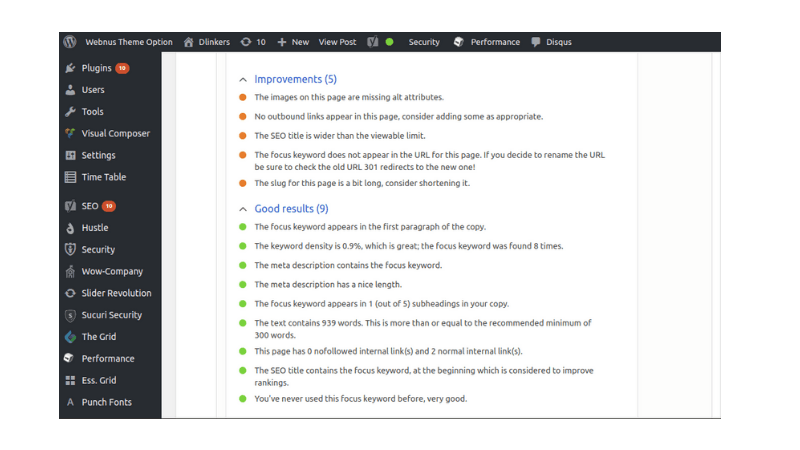
One of Yoast SEO’s greatest assets is its page analysis feature. As the plugin analyzes many aspects of the articles added to your site, it checks how SEO-friendly and how easy to read the content is.
Posts — especially cornerstone posts — undergo in-depth scrutiny from Yoast SEO’s content analysis. And if you’ve used the tool for the first few times, then you might have noticed the red, orange, and green bullets along with the plugin’s assessment report of the content you put out.
And for beginners, these bullets determine whether your content is deemed optimized enough to compete with others for the top spot on SERP. But achieving a green bullet shouldn’t be the end-all goal.
There are other results you have to watch out for too.
As a person who was just introduced into the lovely world of content marketing, you may look at your article and deem it well-written, and extremely rich in information.
There’s nothing wrong with that, of course. But after a second look, you’ll find that there are still some improvements that need to be implemented.
And fortunately, because plugins like Yoast SEO exist, you don’t have to fumble blindly in the dark. It’s not necessarily promoting Yoast or anything, but this is coming from a person who has used the plugin and found it useful — like many others.
Your readability analysis scores show if your article is appropriate for the web — frankly speaking. That’s why it incorporates criteria from Flesch Reading Ease test, as well as checks for transitions words, and your constant use of the passive voice.
According to Yoast’s blog itself, the Flesch Reading Ease assesses your web copy by looking at two aspects of a text:
But isn’t ease in understanding what’s written differ from one person to another? Isn’t readability subjective?
Yes, of course. Your understanding of what’s difficult is different from that of your friend’s. But generally speaking, it is usually believed that a good web copy is easily understood by a 13-15-year old.
One big thing you’ll have to remember when you’re writing for the internet is to pretend like you’re having an actual conversation with a real person. Google’s algorithm is becoming more human-like with every update, and the rise of voice-search is rampant. So, don’t write like you’re providing a news report.
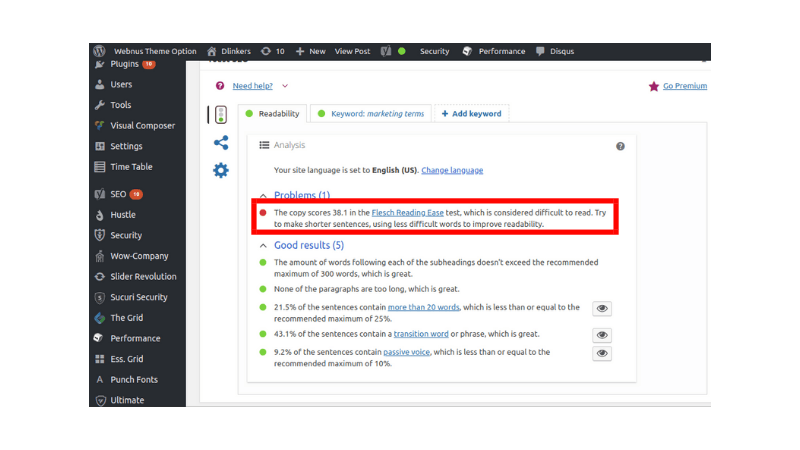
Sticking to simpler alternatives of difficult words instead.
I won’t clutter this article with a grammar lesson. But in writing for the web, transition words help make your text more readable.
Figuratively speaking, transition words are like bridges. They connect one idea to another so you avoid the awkward jumps. The relation between two sentences becomes more apparent when you throw transition words into the mix.
Now, because the use of transition words have factored into the written discussion, does that mean transition words are necessary for SEO?
It’s not a huge factor, but it does help in that it improves readability and text structure. Unfortunately, the use of transition words won’t contribute to you climbing up the rankings.
However, transition words help structure your text. This, in turn, means your readers can understand your text better. With this, you can attract readers to your blog, and some of them might even have an interest in contributing. And all of that means more SEO opportunities.
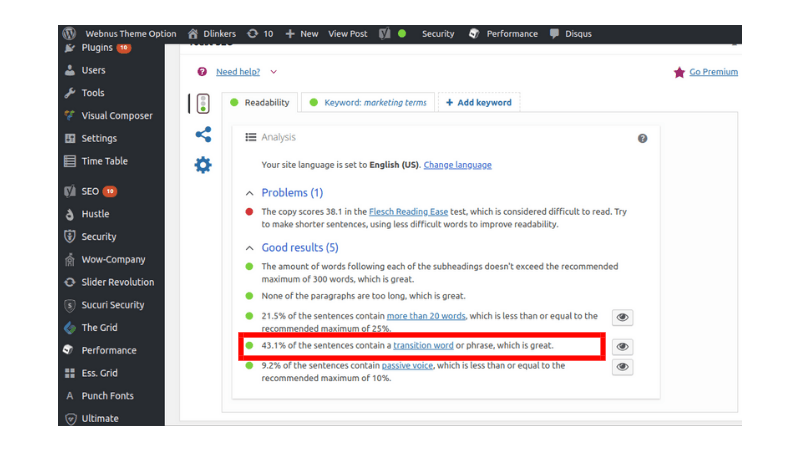
If Yoast’s assessment says your transition words are lacking, then you can go right ahead and add them where possible.
Make sure they belong between two sentences, however. Don’t just add them for the sake of adding them.
Your copy has to make sense. That’s the first and foremost concern.
Let’s take a look at this example provided by Yoast.
As we’ve said before, readability is the key to getting your message through to your readers.
And according to science itself, people understand active voice better than they understand passive voice. Of course, this has something to do with the grammar, but also with the somewhat awkward shift in sentence focus, as well.
The passive voice tells your readers about what was affected, and then the how and why, before you get to who or what was affecting. In other words, the passive voice informs your readers about the essence of the entire article, but in the process also tells a story. It’s telling a short story — albeit a short one.
The active voice, on the other hand, also makes the topic clear immediately. But the tone it carries is more stoic, logical, clipped short, but to-the-point.
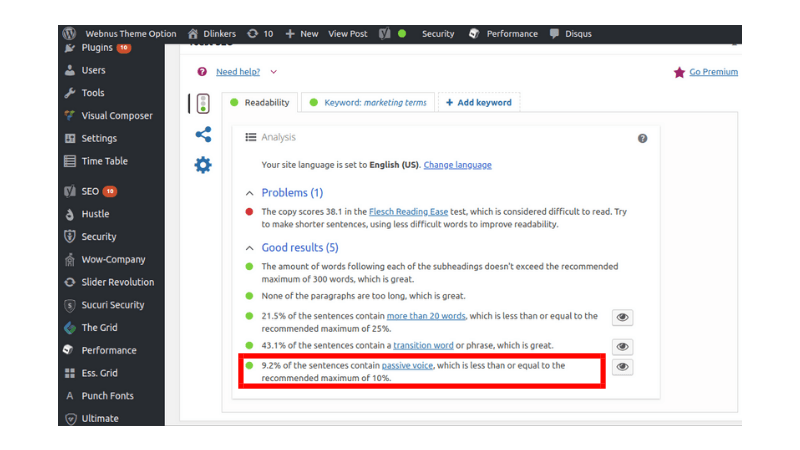
So if your readability assessment from Yoast reports a lot of passive voice, then try to follow the suggestions as much as possible. Perhaps even considering rephrasing some of your sentences.
Web copy optimization is automatically a part of the Yoast SEO plugin. And to rank for search engines, everybody knows that every aspect of a website has to be fully optimized for search engine bot crawling.
You are already aware of target keywords’ importance. Search engines don’t just examine your tags. It examines your copy as well.
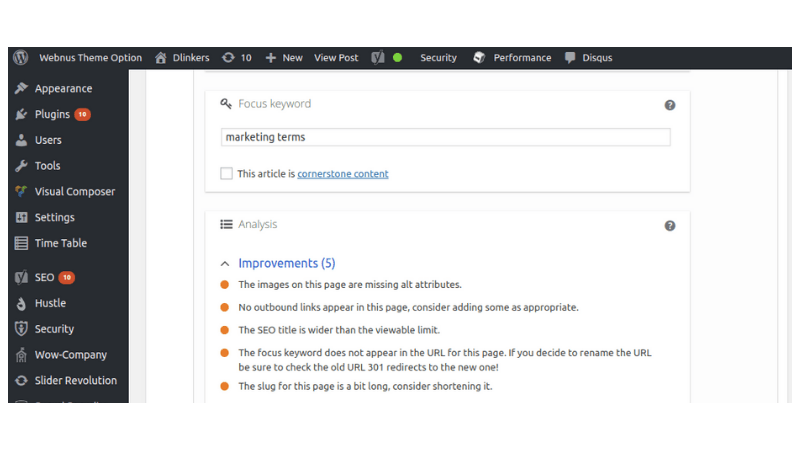
If the keywords in your tags don’t show up in your copy, your site won’t be indexed for those keywords. Moreover, if there’s a significant lack of keywords showing up in your copy, then your chances of being indexed will drop significantly.
Essentially, web copy optimization is the cyber-equivalent of placing huge neon arrows pointing to your website — and your business, of course.
Perhaps it’s time to think twice about those red and orange bullets popping up on Yoast’s SEO page analysis.
After fixing and refining your article’s readability, don’t forget to enter your focus keyphrase — otherwise, your article won’t have anything to rank for.
And we say focus keyphrase because it’s advisable for startup businesses to rank with specific long-tail key phrases; not just broad ones like, say, ‘how to get out of debt.’ Instead, you might want to try something like ‘how to get out of debt and save money.’
Come to think of it, choose your keyphrases from the list you created after conducting your keyword research — which you also thought of while you were writing your article.
Meanwhile, for those of you who have gladly invested in Yoast SEO Premium, its users are given more optimization privileges. It lets you optimize an article for more than one focus keyphrase. With the premium plugin, the tool lets you add synonyms and related key phrases, as well.
Optimizing your article for multiple keyphrases gives you a better chance of ranking the same content for more keywords. And the added bonus? Why, more traffic redirected to your site, of course.
Don’t ignore Yoast’s keyword density results — especially if it’s orange or red.
Although it’s not overly necessary to follow Yoast’s grading system to a specific T, you still have to take your keyword amount into account. And you have to, for good reason too.
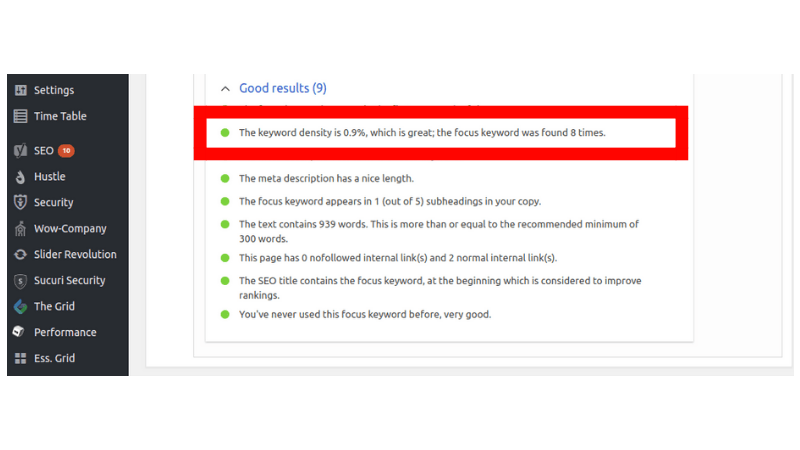
Keywords are one of the building blocks of a search engine optimized site. You don’t want to neglect such a foundation. Adjust your keyword use according to the results.
For instance, if Yoast is telling you that you’re using your focus keyword way too much, perhaps it’s time to switch that out for a different one to avoid keyword stuffing.
Remember that keyword stuffing is a spam technique, and that does more harm than good. It lowers your rankings for the article and your entire site as well.
And if the report says your keywords are lacking, then perhaps you should take care to revise a couple of sentences and include keywords where they would make the most sense being used.
Suggested:
When Yoast tells you that your focus keyword isn’t showing up in your title, or your meta description, then you can count on your content not being optimized well enough. As much as possible, try to include your focus keyword at the beginning of your headline.
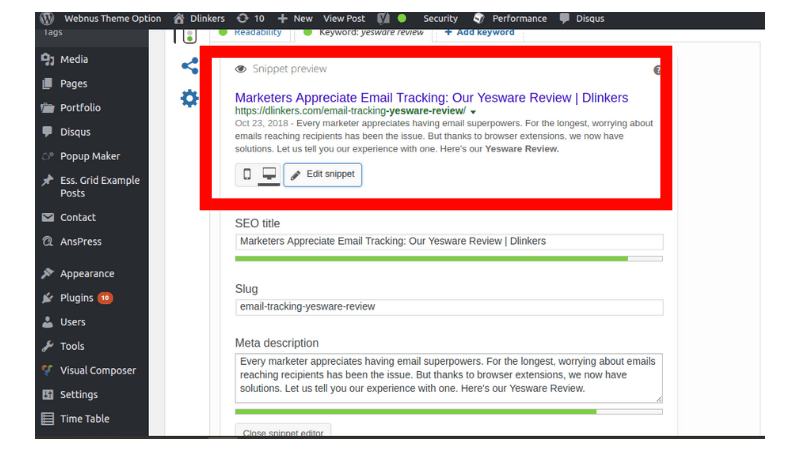
And of course, don’t neglect to compose a well-written, persuasive, and attractive meta description. This acts as the cover of your entire text. And it’s what Google displays on search engines below the URL.
You don’t want a description that’s cut-off with a bunch of ellipses. Maximize the number of characters in the description as much as possible, but don’t overdo it either.
Everything in moderation.
For beginners and experienced marketers alike, SEO copywriting is still hard work. It takes a lot of meticulous research and strategized writing.
A plugin tool like Yoast SEO lightens the web copywriting load. It provides clues where revisions are necessary, and that’s great. And as most of us have figured out by now, following it to a T isn’t necessary.
But there are criteria that you just can’t afford to ignore. Take the necessary ones into account, and you just can’t go wrong.
There is a very good article.
Thank you for sharing
Hello,
I appreciate the questions Illena, and I’ll answer them as best as I can. But first, I need to see if I understand correctly.
– Do you have loading issues with your blog because of Yoast or some other plugin?
– And are you asking for advice on how to optimize content for Google’s Rankbrain?
Hey Bro,
I have tried few only on which you have listed finding difficulty on my blog loading issue as tried with some cache plugins.I have tried with sumo instead monster insight will that be best? Yoast is my best SEO plugin as new Rankbrain come not yet checked if you have any advice on it please share it
Thanks
I am always happy to your post, this is nice and important information.
That Readibility one is a biggie Al. People need to read your work with minimum effort. Yoast is fabulous. Excellent post.
Thank you Ryan. And I totally agree with readability being a big factor. Yoast is indeed a great plugin that’s helped many SEO practitioners in their starting days.
Lovely bit of information. Yoast SEO is pretty popular among webmasters. It gives you lot of feedback ans ways to improve your SEO. Truly a great plugin to have.
Thanks for sharing, have a good one.
Hi, Tarique
Yes, that’s true. I was happy to have shared this. You have a good one too.
I have been using Yoast SEO myself and I find it to be very helpful. With these metrics in place, you know where to work upon and make your post better for your readers. I am glad you have shared this lovely post.
Thanks for sharing, have a good day.
Hi Al,
Yoast plugins has helped many newbies to learn how to improve SEO of blog posts. Yoast page analysis read the content and give suggestions to improve the quality to meet SEO standards. One should also focus on readability to boost content engagement.
Glad you have shared this.
Hi, Gaurav
Yes, that’s very true. As a newbie years ago myself, the Yoast plugin has helped guide me into the do’s and don’ts of content writing. And you are so right in saying that readability is something you shouldn’t ignore.
Hi, Gaurav
I totally agree that Yoast has helped many newbies. Thank you. I was happy to share this too, knowing how Yoast helped me in the beginning as well.
Thanks for information
Hi, David.
I’m glad the information helped. Let me know if you have other questions 🙂